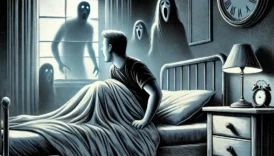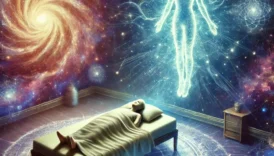Freud and Dream Interpretation
Dreams have captivated human curiosity for centuries, often seen as a window into the soul or a gateway to divine messages. However, Sigmund Freud, the father of psychoanalysis, revolutionized our understanding of dreams by positioning them as reflections of the unconscious mind. His groundbreaking work, The Interpretation of Dreams (1900), laid the foundation for modern dream analysis, offering insights into the complex interplay of desires, fears, and emotions hidden beneath the surface of our conscious awareness.
- Freud and Dream Interpretation
- Freud’s Life and Contribution to Psychology
- The Role of Dreams in Freud’s Theory
- The Structure of Dreams According to Freud
- 1. Manifest Content
- 2. Latent Content
- Dream Distortion and the Unconscious
- Common Symbols in Freud’s Dream Analysis
- Freud’s Method of Dream Interpretation
- Free Association
- Analyzing Personal Context
- Exploring Repressed Desires
- Critiques of Freud’s Dream Theory
- Alternative Perspectives
- Freud’s Legacy in Dream Interpretation
- Conclusion: Freud and the Meaning of Dreams
- Sources
In this article, we explore Freud’s theories on dream interpretation, examining their structure, symbolism, and enduring significance in understanding the human psyche.
Freud’s Life and Contribution to Psychology
Sigmund Freud (1856–1939) was an Austrian neurologist who fundamentally transformed the study of human behavior and the mind. By establishing psychoanalysis, Freud provided tools for understanding the unconscious forces that shape thoughts, emotions, and actions.
Freud’s fascination with dreams began as part of his larger exploration of the human psyche. He believed that dreams serve as a “royal road to the unconscious,” allowing repressed desires and unresolved conflicts to surface in symbolic form. His book, The Interpretation of Dreams, remains a cornerstone of psychoanalytic thought, introducing concepts that continue to influence psychology, literature, and art.
Source: Freud, S. (1900). The Interpretation of Dreams. London: Hogarth Press.
The Role of Dreams in Freud’s Theory
Freud viewed dreams as more than random images or meaningless phenomena. He argued that they are purposeful expressions of the unconscious mind, shaped by two main functions:
- Wish Fulfillment: Dreams are a means of fulfilling repressed desires, especially those that are socially unacceptable or taboo.
- Psychic Relief: Dreams act as a safety valve, releasing mental tension caused by these unexpressed desires.
The Structure of Dreams According to Freud
Freud proposed that dreams have a dual-layered structure:
1. Manifest Content
The manifest content is the surface-level narrative of a dream — the storyline and imagery that we remember upon waking. For example, a dream about climbing a staircase might seem like a simple journey but holds deeper meanings beneath its facade.
2. Latent Content
The latent content represents the hidden, symbolic meaning of the dream. This layer reveals the unconscious wishes and emotions that drive the dream. In Freud’s view, uncovering the latent content requires interpretation, as the true meaning is often disguised by the dream’s manifest content.
Dream Distortion and the Unconscious
Freud introduced the concept of “dream distortion,” wherein the unconscious disguises its true desires through symbolic representations. This distortion occurs to protect the dreamer from directly confronting potentially disturbing or unacceptable thoughts. He identified three key mechanisms involved in this process:
- Condensation: Multiple ideas or emotions are combined into a single image or symbol.
- Displacement: The emotional significance of one object or idea is transferred to another.
- Symbolism: Abstract thoughts or desires are expressed through symbolic images.
For instance, a dream about losing a key might symbolize anxiety over losing control or access to something important in life.
Source: Freud, S. (1913). On Dreams. London: W.W. Norton & Company.
Common Symbols in Freud’s Dream Analysis
Freud emphasized that dreams are rich with symbolic meaning, which often reflects universal human experiences. Some recurring symbols in Freud’s analyses include:
- Water: Represents emotions, the unconscious mind, or life’s flow.
- Staircases: Often linked to sexual desires or life’s progression.
- Keys: Symbolize solutions, access to the unconscious, or unresolved problems.
- Roads or Paths: Reflect life’s journey, choices, or challenges.
- Houses: Represent the self or the body, with different rooms signifying various aspects of one’s inner life.
While Freud acknowledged universal patterns in dream symbols, he stressed that individual experiences shape the specific meanings of these symbols.
Freud’s Method of Dream Interpretation
Freud developed a systematic approach to dream interpretation, rooted in the principles of psychoanalysis. His method involved:
Free Association
Dreamers are encouraged to freely associate words or ideas with the symbols and events in their dreams. This process helps reveal the latent content hidden behind the manifest content.
Analyzing Personal Context
Freud emphasized that understanding a dream’s meaning requires considering the dreamer’s unique experiences, emotions, and conflicts. A staircase, for example, might symbolize ambition for one person but anxiety for another.
Exploring Repressed Desires
Freud believed that most dreams are driven by unfulfilled desires. Analyzing these desires provides insight into the dreamer’s deeper psychological needs and conflicts.
Source: Gay, P. (1989). Freud: A Life for Our Time. New York: W.W. Norton & Company.
Critiques of Freud’s Dream Theory
Freud’s theories have been both celebrated and criticized over the years. Critics argue that his focus on sexual symbolism and repressed desires oversimplifies the complexity of dreams. Others point out the lack of empirical evidence supporting some of his claims.
Alternative Perspectives
- Carl Jung: Jung expanded on Freud’s ideas, proposing that dreams tap into the collective unconscious and archetypal symbols shared across humanity.
- Modern Neuroscience: Contemporary research suggests that dreams may serve cognitive functions such as memory consolidation and emotional processing, challenging Freud’s focus on wish fulfillment.
Despite these critiques, Freud’s insights remain a foundation for exploring the psychological significance of dreams.
Freud’s Legacy in Dream Interpretation
Freud’s contributions to the study of dreams have left an indelible mark on psychology and beyond. His emphasis on the unconscious mind reshaped how we understand human behavior, influencing fields as diverse as literature, art, and philosophy. Even as new theories emerge, Freud’s dream analysis continues to inspire those seeking to understand the mysteries of the mind.
Conclusion: Freud and the Meaning of Dreams
Sigmund Freud’s pioneering work on dreams unveiled the hidden depths of the human psyche. By interpreting dreams as symbolic representations of unconscious desires, Freud provided a powerful framework for understanding the complexities of the mind. While his theories have sparked debate, their impact endures, offering timeless insights into the nature of human thought and emotion.
Exploring Freud’s ideas encourages us to look beyond the surface of our dreams, embracing them as opportunities for self-discovery and psychological growth. Through the lens of Freud’s theories, dreams become more than fleeting images — they are the language of the unconscious, waiting to be understood.
Sources
- Freud, S. (1900). The Interpretation of Dreams. London: Hogarth Press.
- Freud, S. (1913). On Dreams. London: W.W. Norton & Company.
- Gay, P. (1989). Freud: A Life for Our Time. New York: W.W. Norton & Company.
- Jung, C. G. (1968). Man and His Symbols. New York: Dell Publishing.
This comprehensive exploration of Freud’s dream theories invites readers to delve into the profound connections between dreams, the unconscious, and human experience. Let Freud’s insights guide your understanding of the rich, symbolic world of dreams.





